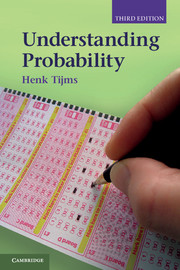Book contents
- Frontmatter
- Contents
- Preface
- Introduction
- PART ONE PROBABILITY IN ACTION
- PART TWO ESSENTIALS OF PROBABILITY
- 7 Foundations of probability theory
- 8 Conditional probability and Bayes
- 9 Basic rules for discrete random variables
- 10 Continuous random variables
- 11 Jointly distributed random variables
- 12 Multivariate normal distribution
- 13 Conditioning by random variables
- 14 Generating functions
- 15 Discrete-time Markov chains
- 16 Continuous-time Markov chains
- Appendix: Counting methods and ex
- Recommended reading
- Answers to odd-numbered problems
- Bibliography
- Index
12 - Multivariate normal distribution
Published online by Cambridge University Press: 05 August 2012
- Frontmatter
- Contents
- Preface
- Introduction
- PART ONE PROBABILITY IN ACTION
- PART TWO ESSENTIALS OF PROBABILITY
- 7 Foundations of probability theory
- 8 Conditional probability and Bayes
- 9 Basic rules for discrete random variables
- 10 Continuous random variables
- 11 Jointly distributed random variables
- 12 Multivariate normal distribution
- 13 Conditioning by random variables
- 14 Generating functions
- 15 Discrete-time Markov chains
- 16 Continuous-time Markov chains
- Appendix: Counting methods and ex
- Recommended reading
- Answers to odd-numbered problems
- Bibliography
- Index
Summary
Do the one-dimensional normal distribution and the one-dimensional central limit theorem allow for a generalization to dimension two or higher? The answer is yes. Just as the one-dimensional normal density is completely determined by its expected value and variance, the bivariate normal density is completely specified by the expected values and the variances of its marginal densities and by its correlation coefficient. The bivariate normal distribution appears in many applied probability problems. This probability distribution can be extended to the multivariate normal distribution in higher dimensions. The multivariate normal distribution arises when you take the sum of a large number of independent random vectors. To get this distribution, all you have to do is to compute a vector of expected values and a matrix of covariances. The multidimensional central limit theorem explains why so many natural phenomena have the multivariate normal distribution. A nice feature of the multivariate normal distribution is its mathematical tractability. The fact that any linear combination of multivariate normal random variables has a univariate normal distribution makes the multivariate normal distribution very convenient for financial portfolio analysis, among others.
The purpose of this chapter is to give a first introduction to the multivariate normal distribution and the multidimensional central limit theorem. Several practical applications will be discussed, including the drunkard's walk in higher dimensions and the chi-square test.
- Type
- Chapter
- Information
- Understanding Probability , pp. 382 - 403Publisher: Cambridge University PressPrint publication year: 2012
- 1
- Cited by



